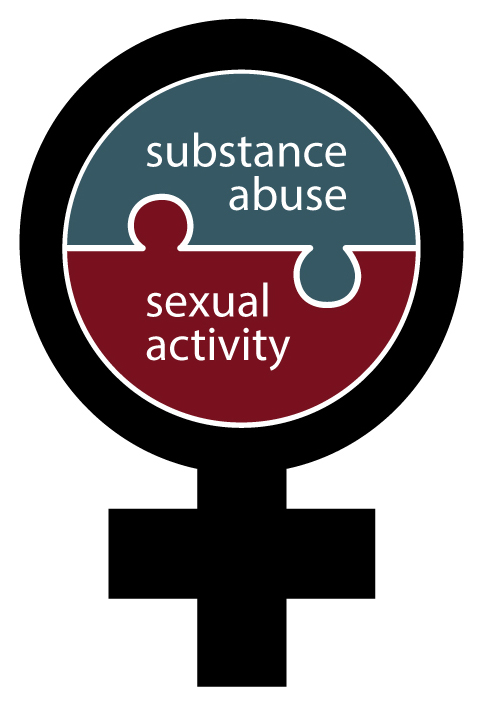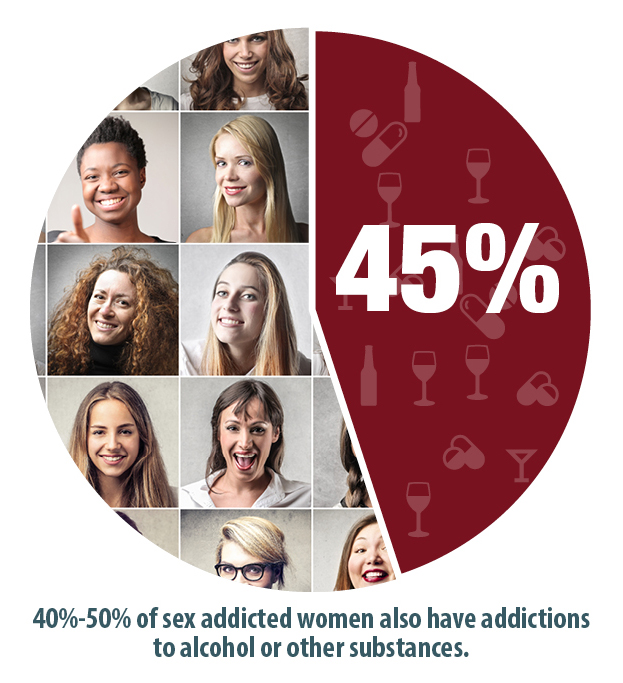Substance use disorder is highly correlated with hypersexuality among women. In 2013, a total of 21.6 million persons aged 12 or older were classified with substance use dependence within the past year (SAMSHA, 2013); furthermore, 40 million Americans ages 12 and older (or more than 1 in 7 people) abuse or are addicted to nicotine, alcohol or other drugs (CASA, 2012). The National Center on Addiction and Substance Abuse at Columbia University (CASA) report that more than 2 million women use illegal drugs and, even more alarming, girls and women are at greater risk for addiction and substance abuse than boys and men (CASA, 2003).
 Substance use and abuse among women who engage in hypersexual behaviors
Substance use and abuse among women who engage in hypersexual behaviors
Substance use disorder is highly correlated with hypersexuality among women. In 2013, a total of 21.6 million persons aged 12 or older were classified with substance use dependence within the past year (SAMSHA, 2013); furthermore, 40 million Americans ages 12 and older (or more than 1 in 7 people) abuse or are addicted to nicotine, alcohol or other drugs (CASA, 2012). The National Center on Addiction and Substance Abuse at Columbia University (CASA) report that more than 2 million women use illegal drugs and, even more alarming, girls and women are at greater risk for addiction and substance abuse than boys and men (CASA, 2003).
 A meta-analysis report, Dangerous Liaisons: Substance Abuse and Sex (CASA, 1999) supports strong connections between substance abuse and sexual activity particularly for women. This report found that teens that drank or used drugs were much more likely to have sex, initiate it at younger ages and have multiple sexual partners, and were, therefore, placing them at higher risk for sexually transmitted diseases (STDs), HIV/AIDS and unintended pregnancies (CASA, 1999; Roller, 2004). Research continues to add that sexual activity can create a “high” equal to that of crack cocaine, amphetamines, compulsive gambling, and risk-taking behaviors with evidence to support the effects it has on the brain (Coleman-Kennedy & Pendley, 2002; Kaplan & Krueger, 2010; Roller, 2004).
A meta-analysis report, Dangerous Liaisons: Substance Abuse and Sex (CASA, 1999) supports strong connections between substance abuse and sexual activity particularly for women. This report found that teens that drank or used drugs were much more likely to have sex, initiate it at younger ages and have multiple sexual partners, and were, therefore, placing them at higher risk for sexually transmitted diseases (STDs), HIV/AIDS and unintended pregnancies (CASA, 1999; Roller, 2004). Research continues to add that sexual activity can create a “high” equal to that of crack cocaine, amphetamines, compulsive gambling, and risk-taking behaviors with evidence to support the effects it has on the brain (Coleman-Kennedy & Pendley, 2002; Kaplan & Krueger, 2010; Roller, 2004).
 Addiction is a serious disease with alcohol, drugs, and hypersexuality related to one another in the addiction cycle that impacts individuals emotionally and physically (Carnes, Carnes, & Baily, 2011; Kasl, 1989). Research indicates that women’s sexual addiction is correlated with a history of drug and alcohol abuse further suggesting that 40%-50% appear to have addictions to alcohol or other substances (Carnes, 1991; Coleman- Kennedy & Pendley, 2002; Opitz, Tsytsarev, & Froh, 2009; Roller, 2004). Similar to substance use disorders, those who engage in hypersexual behaviors experience tolerance, that is, the continual need to increase the amount of time spent in the performance of sexual behavior to cope with emotional pain (Coleman-Kennedy & Pendley, 2002). Kasl’s (1989) work emphasizes that many women cannot begin recovery from substance addiction until they resolve their sexual addiction. Carnes et al. (2011) posit that addiction disables the core ability to recognize what is reality because addiction intertwines a thread of rationalizations and delusions that make it difficult to cope with details like jobs or families; therefore, using substances and hypersexual behaviors to manage become a way of life. As such, assessing hypersexual behaviors among women who currently have a co-occurring substance use disorder diagnosis is crucial to targeted intervention and the overall recovery and health of women in treatment.
Addiction is a serious disease with alcohol, drugs, and hypersexuality related to one another in the addiction cycle that impacts individuals emotionally and physically (Carnes, Carnes, & Baily, 2011; Kasl, 1989). Research indicates that women’s sexual addiction is correlated with a history of drug and alcohol abuse further suggesting that 40%-50% appear to have addictions to alcohol or other substances (Carnes, 1991; Coleman- Kennedy & Pendley, 2002; Opitz, Tsytsarev, & Froh, 2009; Roller, 2004). Similar to substance use disorders, those who engage in hypersexual behaviors experience tolerance, that is, the continual need to increase the amount of time spent in the performance of sexual behavior to cope with emotional pain (Coleman-Kennedy & Pendley, 2002). Kasl’s (1989) work emphasizes that many women cannot begin recovery from substance addiction until they resolve their sexual addiction. Carnes et al. (2011) posit that addiction disables the core ability to recognize what is reality because addiction intertwines a thread of rationalizations and delusions that make it difficult to cope with details like jobs or families; therefore, using substances and hypersexual behaviors to manage become a way of life. As such, assessing hypersexual behaviors among women who currently have a co-occurring substance use disorder diagnosis is crucial to targeted intervention and the overall recovery and health of women in treatment.




Leave a Reply
You must be logged in to post a comment.